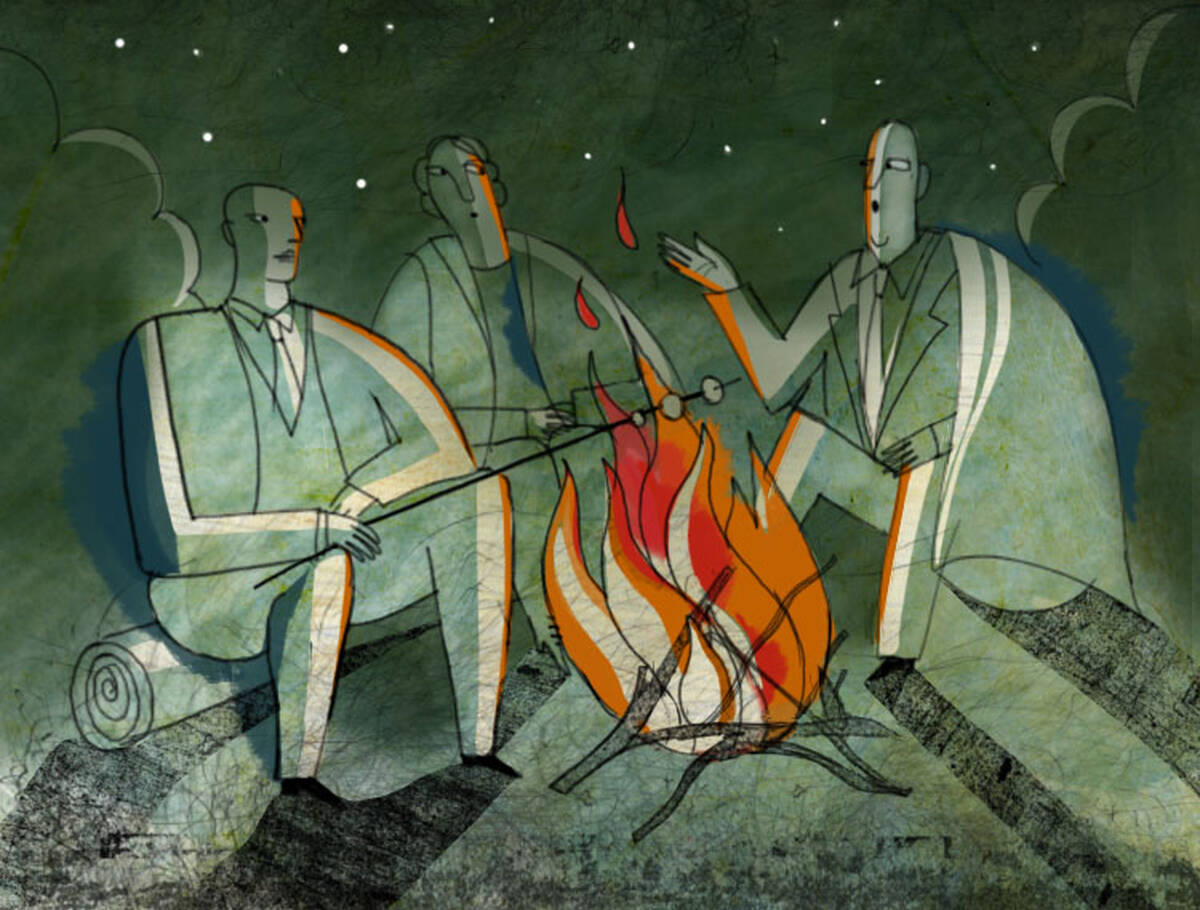The art of storytelling may conjure up images of telling tall tales around a campfire or artsy live lit events. But storytelling is also a key business skill worth cultivating. It can serve as an essential tool for closing a deal, impressing your boss, or making your brand more relatable to consumers.
Stories let you connect with your audience on an emotional level. They help you convey key information in a way that will be remembered and help you persuade your audience to take action. This holds true for both spoken and written stories as well as the stories you want to tell with data.
In this month’s Insight In Person podcast, you’ll hear from two Kellogg School professors and a lecturer about the power of storytelling, as well as their tips to become a better storyteller.
PODCAST TRANSCRIPT
[Music prelude]
Emily STONEHere’s a little exercise: Think of all the ways that we compare our lives to stories: We want to “start a new chapter in life,” or “turn the page” on something, or wonder, “What’s her story?”
As humans, we are hardwired to organize our thoughts through stories. They comprise everything from our creation myths to the anecdotes politicians use to pepper their speeches. Stories make us relatable to each other and connect to people’s emotions.
They’re also a powerful business tool. If you have key information you want others to remember, tell them a story. If you want to use data to persuade people to take action, build visualizations to convey that data as a story.
In this month’s Insight In Person podcast, we’ll hear from two Kellogg professors and a Kellogg lecturer about the best ways to tell stories. I’m your host, Emily Stone. So stay tuned.
[Music interlude]
Michelle BUCK“What’s your story?” The question, “What’s your story?” is like asking, “What do you have to say? Really, at the end of the day, What do you stand for? How do you want to be known?”
STONEThat’s Michelle Buck, a clinical professor of management and organizations at the Kellogg School. She believes that in order to lead effectively, it is paramount that leaders first clarify who they are and what they stand for. In other words, they need to master their own story.
Buck calls this a capital S story. A capital S story is different from what she calls little S stories, the anecdotes that are usually what we expect when we hear, “Let me tell you a story.”
A capital S story hones a leader’s vision and purpose. It is the narrative that acts as a compass, steering leaders in the right direction. It can also drum up support for a leader’s initiatives. And that is especially important, given that studies show that only about 20 percent of workers globally feel a sense of meaning in their work.
BUCKTherefore, when leaders have that sense of purpose in their story, that transmits or translates to the people whom they’re leading as well and makes the work much more engaging, therefore more productive, possibly more innovative, and ultimately, more profitable as well.
STONEA capital S story also provides leaders with a sense of agility.
BUCKBecause when decisions are required in a very quick manner, we’re living in a constantly changing environment. You have to be able to access what matters most very, very quickly.
STONESo what can leaders do to get their capital S story straight? In her executive education courses, Buck guides her students through a variety of exercises.
One asks people to think of their life as a book and to title the different chapters. What chapters have already happened? What chapter are they in now?
BUCKMore importantly, in terms of identifying an underlying sense of identity or purpose or story, we ask people to think about, “Is there some theme that connects the dots of the otherwise totally different experiences of your life?”
STONEAn exercise like this, as simple as it sounds, can take you to some profound places. Buck describes an instance where an executive in one of her courses was reflecting on who he was, and what experiences had shaped him.
He started talking about his mother—artsy, a dreamer—and his father—a stalwart for logic. And then, he had an epiphany.
BUCKHis whole life was working as a bridge builder. In his job, he was the person who was always bringing people from different functions and different departments together who otherwise may not talk. He came from a part of the world that had great racial and socioeconomic tensions, and he was always the person who was connecting the dots. He saw a theme that he had never thought about before because of one of these reflective exercises. He said that it completely changed the way he thought about the work ahead of him, and the contribution that he could make, and reframing what he was offering.
STONECapital S stories aren’t just useful for leaders. People across organizations—and even organizations themselves—can use stories to help people make sense of change.
BUCKMany leaders, during times of change will invoke the story metaphor and the idea of chapters in the book and say, “What do we want our next chapter to be? What is the chapter that we are going to write together that builds upon the story that we’ve been living for 10 years, 100 years?” That then serves as an invitation to current employees to be part of writing the narrative, which is incredibly compelling as well.
[Music interlude]
STONESo capital S storytelling helps you shape the path ahead. But what about those little S stories?
Esther CHOYStorytelling is important because it is the most fundamental and shared human intelligence. It is the real fundamental way of how we learn, how we share, how we formulate our experience and how we tell others about it.
STONEThat’s Esther Choy. She’s a Kellogg alum and lecturer, who is also the founder of the Leadership Story Lab, where she teaches people how to perfect telling those little S stories. She stresses that storytelling isn’t only about getting up in front of a crowd and telling a story—though that’s part of the craft.
CHOYStorytelling doesn’t have to always take a long time. You can have a two-lined, brief sentence of a story.
STONEThink about how we use storytelling when we run into a friend who asks how work is, or when a manager demands to know why an important project isn’t ready yet. More broadly, Choy says to think about storytelling as an organizing principle for business communication.
The goal of all these storytelling moments is to make you relatable to the other person, make the information you’re presenting persuasive, and get your audience to take a desired action.
CHOYAssume they’re not interested, assume they have better things to do than listen to you, assume they don’t understand what you’re saying—and storytelling is the most accessible way to build that bridge.
STONESo how do you build that bridge? What are the best ways to tell your story?
To start with, don’t just deluge your audience with all the facts that you think are important. First, you want to get your audience engaged, be it the corporate board that you hope adopts your restructuring plan or the person at a cocktail party you’re trying to network with.
Think of storytelling as the strategic ordering of facts and emotions.
CHOYThere is a time to data dump, there is a time to intrigue and delight. I always encourage people to create that thirst first. Why should they pay attention? Why should they put down their phone? Why should they stop looking out the window?
STONEChoy teaches whole workshops on how to craft a good story, but she offers up a few quick tips to get you started.
CHOYFocus on the beginning and the end. Make sure the middle is solid, but focus on the beginning and the end. The beginning is how you get their attention, how you motivate them to keep paying attention. The end is what they most likely will remember, an hour, a day, a week, a month, a year after you tell the story.
STONENext, Choy suggests taking your story out for a test-drive. Tell it to a few trusted friends or colleagues to get their reaction. And be specific about what sort of feedback you want.
She says to ask your test audience three questions: First, does the story get their imagination going? Second, do they find it relatable? Third, and this is key, what is the listener going to do after hearing your story. Because, in the end, the stories you tell in a business context are all about getting people to take action.
CHOYSo the way to gauge how effective your story is is to get that feedback. Do you want to do anything about it? Would you hit “Send”? Would you click to the next page? Would you ask me more questions about this product? So on and so forth.
[Music interlude]
STONELet’s say you want to get people to act by showing them the amazing data you’ve gathered. Won’t the numbers alone persuade your audience and get them to take action?
Nope. You need to get that data to tell a story. Remember, don’t just “data dump.” The best way to do that is to create a data visualization. That’s according to Steven Franconeri, a Northwestern psychology professor who also teaches management and organization courses at Kellogg.
If you’re shaking your head and think that just handing out a spreadsheet is all you need to do, here’s what Franconeri has to say.
Steven FRANCONERIIf you really feel that you’re able to communicate with just numbers, that could be true, but give it a test. So actually try to have people repeat back to you what they think the important aspects of your story, of your prescription, are. And see what comes back. Often you’ll be surprised. If you are not using visualizations and you feel like it’s sufficient, it might be overconfidence.
STONEData visualizations are a key tool for business leaders, Franconeri says, in part because of the way our brains are hardwired. Forty percent of our brains are devoted to visual processing. Once upon a time, that helped us spot a lion lurking behind a bush. Now it can be harnessed to get your boss to approve your marketing plan, or your employees to buy into a new incentive program.
FRANCONERIIt can be far superior to communicate patterns and data to people’s visual system rather than their verbal system. So the visual system lets you take in a pattern of information more deeply and more broadly, and it makes you process it more deeply. When you want people to pay attention to data—not just anecdotes or gut instincts, but data, hard numbers—it’s helpful to convey them in this visual form so that they sink in better.
STONEOkay, so you’re ready to use a visualization to dazzle your audience. How do you go about creating it?
The first thing, Franconeri says, is to make sure that you’re telling the story you want to tell. Because when faced with data, your audience is automatically going to convert it into a story.
FRANCONERIIf you just let people stare at a complex visualization, they will make their own story, and they’ll pick different views, and they’ll pick them in an order that their brain designs, and it won’t be your story. You need to pick a set of views and put them in order that tells the narrative that you want people to follow to understand the problem that you have and the solution that you’re proposing, so that they think about that sequence in the same way that you do in your brain.
STONETo ensure that your story gets told, Franconeri echoes some of Choy’s advice: Take your visualization out for a test-drive. Create a few different types of visualizations—say, a bar graph, a line graph, and a scatter chart—and then do a few iterations within those styles, testing different ways of ordering and arranging the data points within each graph.
FRANCONERIShow those different possibilities to a few colleagues or friends and ask them what story they see in the data. You’ll be amazed at the differences.
Just imagine a simple line graph generally going up but with a few bumps in it. Just when you show something like that, there are several stories that people could be seeing in that: the fact that there are two bumps, the fact that it’s going up in general, the fact that the acceleration goes down a little bit, that the growth seems to be diminishing. You need to be able to understand what other people see in those patterns. Because once you’ve been staring at the data for many hours with your analyst hat on, you can get locked into a state where you see certain patterns, but you don’t realize that other people don’t.
STONEThere are other key rules for making a good data visualization. Make sure you give it a nice, crisp title that highlights the story you want to tell, keep the look minimalist so you aren’t providing distracting visual clutter, and be sure to guide your viewer through the data so you don’t lose anyone along the way.
FRANCONERIThen when you take a series of those and put them in sequence—“so you should see this aspect of the data, and now, let’s switch to this aspect of the data, and this aspect of the data”—and you guide people through that sequence in a logical way, that’s a data story.
STONEFranconeri also stresses that these visualization rules are important for business leaders, even if they have a staff that can pretty up the slides.
FRANCONERIYour art department can make the visualization look good, but they can’t make it tell the story that you want. As the leader or as the analyst, you are the person who knows what’s important in the data. You are the person who knows what everyone else in the room needs to know and what actions they should take. Knowing just these simple rules about how to make your visualization effective, combined with the knowledge that’s in only your head, can make it an incredibly effective tool.
[Music interlude]
STONEThis program was produced by Jessica Love, Kate Proto, Fred Schmalz, Emily Stone, and Michael Spikes.
Special thanks to Kellogg professors Michelle Buck and Steven Franconeri, as well as lecturer Esther Choy.
You can stream or download our monthly podcast from iTunes, or from our website, where you can read more about leadership and data visualization. Visit us at insight.kellogg.northwestern.edu. We’ll be back next month with another Insight In Person podcast.
Featured Faculty
Clinical Professor of Executive Education
Previously an Adjunct Lecturer of Family Enterprise at Kellogg
Professor of Psychology, Weinberg College of Arts & Sciences; Professor of Design, McCormick School of Engineering (Courtesy); Director, Northwestern Cognitive Science Program; Professor of Management and Organizations (Courtesy)




